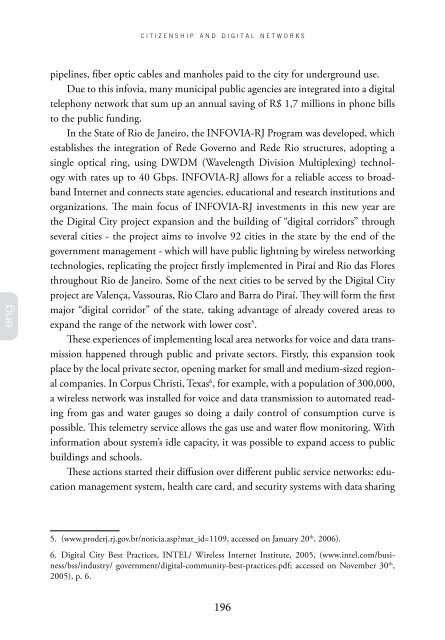Sergio Amadeu da Silveira - Cidadania e Redes Digitais
Sergio Amadeu da Silveira - Cidadania e Redes Digitais
Sergio Amadeu da Silveira - Cidadania e Redes Digitais
Create successful ePaper yourself
Turn your PDF publications into a flip-book with our unique Google optimized e-Paper software.
eng<br />
c i t i z e n s h i p a n d d i g i t a l n e t w o r k s<br />
pipelines, fiber optic cables and manholes paid to the city for underground use.<br />
Due to this infovia, many municipal public agencies are integrated into a digital<br />
telephony network that sum up an annual saving of R$ 1,7 millions in phone bills<br />
to the public funding.<br />
In the State of Rio de Janeiro, the INFOVIA-RJ Program was developed, which<br />
establishes the integration of Rede Governo and Rede Rio structures, adopting a<br />
single optical ring, using DWDM (Wavelength Division Multiplexing) technology<br />
with rates up to 40 Gbps. INFOVIA-RJ allows for a reliable access to broadband<br />
Internet and connects state agencies, educational and research institutions and<br />
organizations. The main focus of INFOVIA-RJ investments in this new year are<br />
the Digital City project expansion and the building of “digital corridors” through<br />
several cities - the project aims to involve 92 cities in the state by the end of the<br />
government management - which will have public lightning by wireless networking<br />
technologies, replicating the project firstly implemented in Piraí and Rio <strong>da</strong>s Flores<br />
throughout Rio de Janeiro. Some of the next cities to be served by the Digital City<br />
project are Valença, Vassouras, Rio Claro and Barra do Piraí. They will form the first<br />
major “digital corridor” of the state, taking advantage of already covered areas to<br />
expand the range of the network with lower cost 5 .<br />
These experiences of implementing local area networks for voice and <strong>da</strong>ta transmission<br />
happened through public and private sectors. Firstly, this expansion took<br />
place by the local private sector, opening market for small and medium-sized regional<br />
companies. In Corpus Christi, Texas 6 , for example, with a population of 300,000,<br />
a wireless network was installed for voice and <strong>da</strong>ta transmission to automated reading<br />
from gas and water gauges so doing a <strong>da</strong>ily control of consumption curve is<br />
possible. This telemetry service allows the gas use and water flow monitoring. With<br />
information about system’s idle capacity, it was possible to expand access to public<br />
buildings and schools.<br />
These actions started their diffusion over different public service networks: education<br />
management system, health care card, and security systems with <strong>da</strong>ta sharing<br />
5. (www.proderj.rj.gov.br/noticia.asp?mat_id=1109, accessed on January 20 th , 2006).<br />
6. Digital City Best Practices, INTEL/ Wireless Internet Institute, 2005, (www.intel.com/business/bss/industry/<br />
government/digital-community-best-practices.pdf; accessed on November 30 th ,<br />
2005), p. 6.<br />
196


